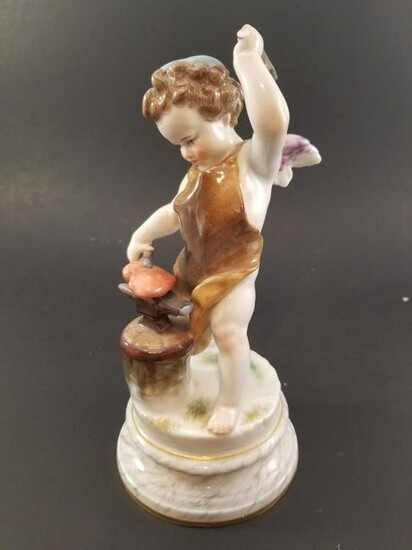Meissen Cupid L-114 "Forging A Heart" Circa 1880
This Is A Portrayal Of Cupid Forging A Heart. The Meissen Model L 114 Was Made In The Late 19Th Century And It Has Still Retained The Good Look. The Porcelain Finish Is Still Smooth And There Aren£Any Scratches In It. This Figurine Does Have 2 Areas That Have Broken Off Which You Can See In The Pictures. One Broken Piece Is On The Bottom Of The Handle Of The Hammer And The Other Is The Bottom Of The Tongs Holding The Heart That Have Broken Off. This Cupid Originally Belonged To A Set Of 26 Figures, Which Was Molded By Heinrich Schwabe. It Took Him Over Three Years, From 1877 To 1880 To Make These 26 Figures. That£ Because He Made All The 26 Figures, Including The Cupid With His Own Hands. As A Result Of The Handmade Design, Special Attention Has Been Paid Towards Every Little Detail Of The Cupid As Well. The Colors Are So Vibrant And You Can See The Individual Brush Strokes In The Hair And On The Wings. This Has Been Done With One Of The Best Artists And It Looks Really Amazing. Meissen porcelain or Meissen china was the first European hard-paste porcelain. Early experiments were done in 1708 by Ehrenfried Walther von Tschirnhaus. After his death that October, Johann Friedrich Böttger continued von Tschirnhaus's work and brought this type of porcelain to the market, financed by Augustus the Strong, King of Poland and Elector of Saxony. The production of porcelain in the royal factory at Meissen, near Dresden, started in 1710 and attracted artists and artisans to establish, arguably, the most famous porcelain manufacturer known throughout the world. Its signature logo, the crossed swords, was introduced in 1720 to protect its production; the mark of the swords is reportedly one of the oldest trademarks in existence. In English Dresden porcelain was once the usual term for these wares, especially the figures; this is because Meissen is geographically not far from Dresden which is the Saxon capital.
Condition Report: The absence of a condition report does not imply that the lot is in perfect condition. Please carefully read our terms of sale, shipping pick up & payment information. We are happy and willing to answer questions about any of our lots as well as to send additional images. It is the responsibility of the bidder to pose any questions BEFORE bidding. Please email us for a shipping quote if needed. All sales are final.
View it on
Estimate
Time, Location
Auction House
This Is A Portrayal Of Cupid Forging A Heart. The Meissen Model L 114 Was Made In The Late 19Th Century And It Has Still Retained The Good Look. The Porcelain Finish Is Still Smooth And There Aren£Any Scratches In It. This Figurine Does Have 2 Areas That Have Broken Off Which You Can See In The Pictures. One Broken Piece Is On The Bottom Of The Handle Of The Hammer And The Other Is The Bottom Of The Tongs Holding The Heart That Have Broken Off. This Cupid Originally Belonged To A Set Of 26 Figures, Which Was Molded By Heinrich Schwabe. It Took Him Over Three Years, From 1877 To 1880 To Make These 26 Figures. That£ Because He Made All The 26 Figures, Including The Cupid With His Own Hands. As A Result Of The Handmade Design, Special Attention Has Been Paid Towards Every Little Detail Of The Cupid As Well. The Colors Are So Vibrant And You Can See The Individual Brush Strokes In The Hair And On The Wings. This Has Been Done With One Of The Best Artists And It Looks Really Amazing. Meissen porcelain or Meissen china was the first European hard-paste porcelain. Early experiments were done in 1708 by Ehrenfried Walther von Tschirnhaus. After his death that October, Johann Friedrich Böttger continued von Tschirnhaus's work and brought this type of porcelain to the market, financed by Augustus the Strong, King of Poland and Elector of Saxony. The production of porcelain in the royal factory at Meissen, near Dresden, started in 1710 and attracted artists and artisans to establish, arguably, the most famous porcelain manufacturer known throughout the world. Its signature logo, the crossed swords, was introduced in 1720 to protect its production; the mark of the swords is reportedly one of the oldest trademarks in existence. In English Dresden porcelain was once the usual term for these wares, especially the figures; this is because Meissen is geographically not far from Dresden which is the Saxon capital.
Condition Report: The absence of a condition report does not imply that the lot is in perfect condition. Please carefully read our terms of sale, shipping pick up & payment information. We are happy and willing to answer questions about any of our lots as well as to send additional images. It is the responsibility of the bidder to pose any questions BEFORE bidding. Please email us for a shipping quote if needed. All sales are final.



